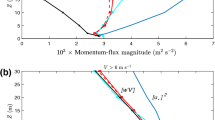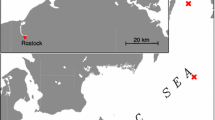Abstract
Observations obtained mainly from a research aircraft are presented of the mean and turbulent structure of the stably stratified internal boundary layer (IBL) over the sea formed by warm air advection from land to sea. The potential temperature and humidity fields reveal the vertical extent of the IBL, for fetches out to several hundred of kilometres, geostrophic winds of 20–25 m s−1, and potential temperature differences between undisturbed continental air and the sea surface of 7 to 17 K. The dependence of IBL depth on these external parameters is discussed in the context of the numerical results of Garratt (1987), and some discrepancies are noted.
Wind observations show the development of a low-level wind maximum (wind component normal to the coast) and rotation of the wind to smaller cross-isobar flow angles. Potential temperature (θ) profiles within the IBL reveal quite a different structure to that found in the nocturnal boundary layer (NBL) over land. Over the sea, θ profiles have large positive curvature with vertical gradients increasing monotonically with height; this reflects the dominance of turbulent cooling within the layer. The behaviour is consistent with known behaviour in the NBL over land where curvature becomes negative (vertical gradients of θ decreasing with height) as radiative cooling becomes dominant.
Turbulent properties are discussed in terms of non-dimensional quantities, normalised by the surface friction velocity, as functions of normalised height using the IBL depth. Vertical profiles of these and the normalised wavelength of the spectral maximum agree well with known results for the stable boundary layer over land (Caughey et al., 1979).
Similar content being viewed by others
References
André, J. C. and Mahrt, L.: 1982, ‘The Nocturnal Surface Inversion and Influence of Clear Air Radiative Cooling’, J. Atmos. Sci. 39, 864–878.
Caughey, S. J., Wyngaard, J. C., and Kaimal, J. C.: 1979, ‘Turbulence in the Evolving Stable Boundary Layer’, J. Atmos. Sci. 36, 1041–1052.
Friehe, C. A., LaRue, J. C., Champagne, F. H., Gibson, C. H., and Dreyer, G. F.: 1975, ‘Effects of Temperature and Humidity Fluctuations on the Optical Refractive Index in the Marine Boundary Layer’, J. Optical Soc. Amer. 65, 1502–1511.
Garratt, J. R.: 1977, ‘Review of Drag Coefficients over Oceans and Continents’, Mon. Wea. Rev. 105, 915–929.
Garratt, J. R.: 1982, ‘Observations in the Nocturnal Boundary Layer’, Boundary-Layer Meteorol. 22, 21–48.
Garratt, J. R.: 1987, ‘The Stably Stratified Internal Boundary Layer for Steady and Diurnally Varying Offshore Flow’, Boundary-Layer Meteorol. 39, 369–394.
Garratt, J. R. and Brost, R. A.: 1981, ‘Radiative Cooling Effects within and above the Nocturnal Boundary Layer’, J. Atmos. Sci. 38, 2730–2746.
Hsu, S. A.: 1983, ‘On the Growth of a Thermally Modified Boundary Layer by Advection of Warm Air over a Cooler Sea’, J. Geophys. Res. 88, 771–774.
Johnson, H. D., Lenschow, D. H., and Danninger, K.: 1978, ‘A New Fixed Vane for Measuring Air Motion. Preprints, Fourth Symposium on Meteorological Observations and Instrumentation’, Amer. Meteorol. Soc. Boston, Mass., U.S.A., pp. 467–470.
Mulhearn, P. J.: 1981, ‘On the Formation of a Stably Stratified Internal Boundary Layer by Advection of Warm Air over a Cooler Sea’, Boundary-Layer Meteorol 21, 247–254.
Pasquill, F. and Smith, F. B.: 1983, Atmospheric Diffusion, Third Edition, J. Wiley and Sons, New York, 437 pp.
Raynor, G. S., Sethuraman, S., and Brown, R. M.: 1979, ‘Formation and Characteristics of Coastal Internal Boundary Layers during Onshore Flows’, Boundary-Layer Meteorol. 16, 487–514.
Ryan, B. F., Wilson, K. J., Garratt, J. R., and Smith, R. K.: 1985, ‘Cold Fronts Research Programme: Progress, Future Plans and Research Directions’, Bull. Amer. Meteorol. Soc. 66, 1116–1122.
Venkatram, A.: 1977, ‘A Model of Internal Boundary-layer Development’, Boundary-Layer Meteorol. 11, 419–437.
Venkatram, A.: 1986, ‘An Examination of Methods to Estimate the Height of the Coastal Internal Boundary Layer’, Boundary-Layer Meteorol. 36, 149–156.
Wyngaard, J. C.: 1973, ‘Chapter 3 in Workshop on Micrometeorology’, D. A. Haugen (ed.), Amer. Meteorol. Soc., 392 pp.
Yamada, T.: 1979, ‘Prediction of the Nocturnal Surface Inversion Height’, J. Appl. Meteorol. 18, 526–531.
Author information
Authors and Affiliations
Rights and permissions
About this article
Cite this article
Garratt, J.R., Ryan, B.F. The structure of the stably stratified internal boundary layer in offshore flow over the sea. Boundary-Layer Meteorol 47, 17–40 (1989). https://doi.org/10.1007/BF00122320
Received:
Issue Date:
DOI: https://doi.org/10.1007/BF00122320




